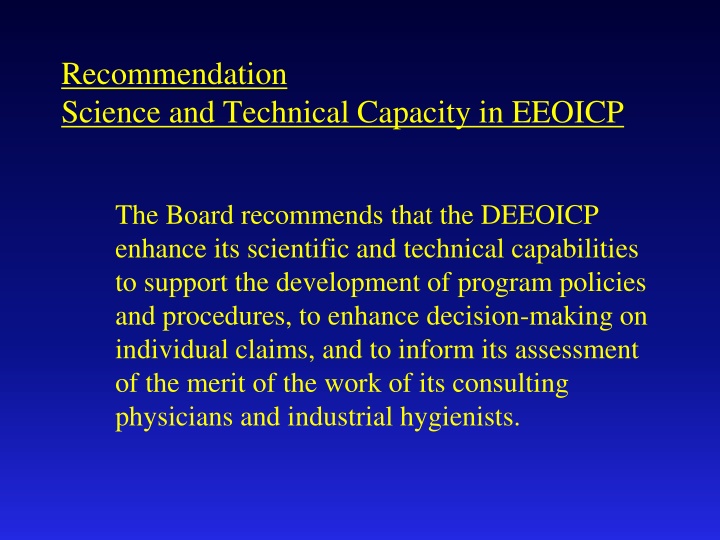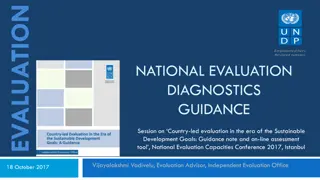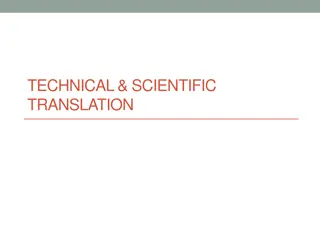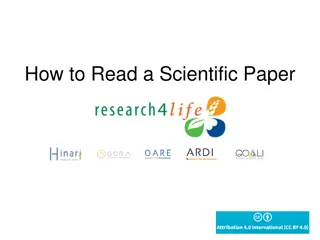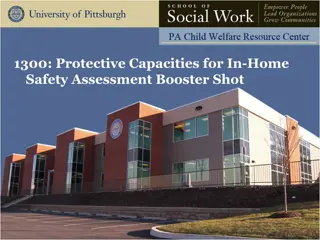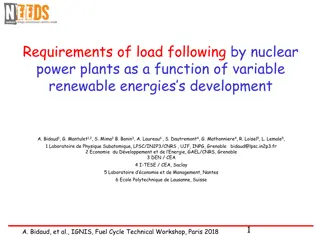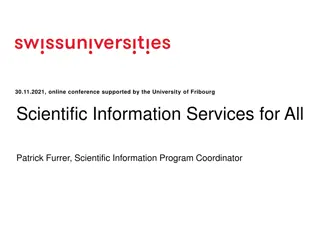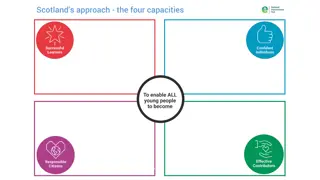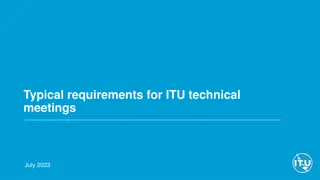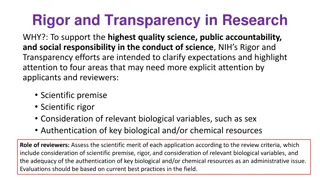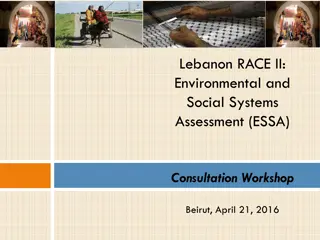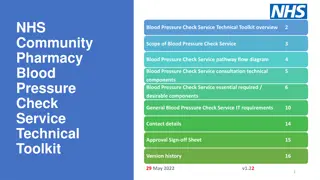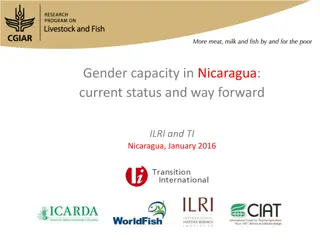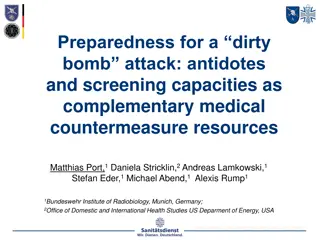Enhancing Scientific and Technical Capacities in EEOICP
The Board recommends enhancing scientific and technical capabilities in DEEOICP to support policy development, improve decision-making on claims, and assess the work of consulting physicians and industrial hygienists. The rationale includes recommendations to improve the DOL Site Exposure Matrices, address gaps in updating the Haz-Map database, and ensure policies align with current scientific knowledge.
Download Presentation

Please find below an Image/Link to download the presentation.
The content on the website is provided AS IS for your information and personal use only. It may not be sold, licensed, or shared on other websites without obtaining consent from the author.If you encounter any issues during the download, it is possible that the publisher has removed the file from their server.
You are allowed to download the files provided on this website for personal or commercial use, subject to the condition that they are used lawfully. All files are the property of their respective owners.
The content on the website is provided AS IS for your information and personal use only. It may not be sold, licensed, or shared on other websites without obtaining consent from the author.
E N D
Presentation Transcript
Recommendation Science and Technical Capacity in EEOICP The Board recommends that the DEEOICP enhance its scientific and technical capabilities to support the development of program policies and procedures, to enhance decision-making on individual claims, and to inform its assessment of the merit of the work of its consulting physicians and industrial hygienists.
Rationale The Institute of Medicine s Review of the DOL Site Exposure Matrices (SEM) in 2013 made numerous recommendations to improve the SEM. These include 1) making sure that the SEM incorporate readily available supplemental data sources into the SEM to provide a more complete picture of known exposure- disease links, and 2) forming an expert advisory panel to establish explicit causal criteria for use by the EEOICP, design and implement a method for reviewing possible exposure-disease links, and identify and peer review new exposure-disease links for use in the SEM.
Rationale The Board notes that the EEOICP has ended its contract with the National Library of Medicine for the continued updating of the Haz-Map database that is integral to the SEM.
Rationale The Board has been asked by EEOICP to provide input into numerous possible exposure-disease links. While the Board will assist in this request to the extent possible, it is noted that the Board members have full- time positions in addition to serving on the Board and has, at present, as a Board, no scientific staff or contracted resources to address this request. Moreover, evaluating exposure-disease links is an ongoing task for which the EEOICP needs permanent capacity to complete.
Rationale The Board has observed that numerous current EEOICP policies involving important diseases and exposure-disease links, including chronic obstructive lung disease, asbestos-related diseases, asthma, and others, are not based fully on state-of-the-art scientific knowledge. The Board is willing to assist the Department of Labor in implementing this recommendation.
Steven Markowitz MD, DrPH, April 19, 2017 Use of Presumptions in EEOICP 1. Presumptions: attributes 2. Presumptions in EEOICPA, 2001 3. Asbestos-related diseases 4. Asthma
Presumptions 1. Fairness 2. Consistency 3. Timeliness 4. Efficiency 5. Error threshold 6. Positive vs. negative presumptions
EEOICPA Exposure presumptions in Act 1. Special exposure cohort: > 250 days work in GDP before 2/1/92 in a job where dosimetry monitoring was performed or in comparable job 2. Silica exposure: was present > 250 days during mining of tunnels at DOE facility in NV or AK
Presumption elements Exposure: Duration Job title (proxy for intensity, frequency, task) Calendar years Latency Disease: diagnostic criteria
Exposure Presumptions, Part B in EEOICPA, 2000 Exposure criteria Cancer Silica Comments Duration > 250 days > 250 days NTS, Amchitka Job title If dosimetry was performed or comparable job present during mining When mining was active Calender years Before 2/92 Latency - -
Asbestos EEOICP Procedures Manual, Chapter 2: 1000 0-700, Exhibit 3 (added post-Circ. 15-05) EEOICPA Bulletin No. 13-02 EEOICPA Circular No. 15- 05
EEOICPA CIRCULAR NO.15- 05 Asbestos-related diseases (ARD) Asbestosis Asbestos-related pleural disease Lung cancer Mesothelioma (chest, abdomen) Cancer of larynx Cancer of ovary COPD
EEOICP Procedures Manual, Chapter 2 Asbestos Exposure: Assessing asbestosis claims: DEEOIC accepts that asbestos was a common toxic substance that existed throughout all DOE facilities. While asbestos did exist at DOE facilities, the nature of an employee s exposure would have varied based on different factors such as the period that the employee worked, the type of work performed, and the location of employment. Disease: focuses on medical criteria
EEOICPA Bulletin No. 13-02 Asbestos and Ovarian Cancer Exposure presumption: prior to 1986, and 250 days of significant asbestos exposure (worked in a job title in List A) 20 years latency period from initial DOE exposure to asbestos Or diagnosis of asbestosis or mesothelioma
Significant Asbestos Exposure: Associated Labor Categories and Job Tasks (ATSDR 2014) Automotive mechanic; Vehicle mechanic; Vehicle maintenance mechanic Boilermaker Carpenter; Dry waller; Plasterer Demolition technician; Laborer Electrical mechanic; Electrician; Floor covering worker Furnace & saw operator; Furnace builder; Furnace operator; Furnace puller; Furnace technician; Furnace tender; Furnace unloader Glazier; Glass installer; Glazer Grinder operator; Mason (concrete grinding); Tool grinder; Maintenance mechanic (general grinding); Welder (general grinding); Machinist (machine grinding) Insulation worker; Insulation trade worker; Insulator Ironworker; Ironworker-rigger Maintenance mechanic; Electrician; Insulator; Mason; Brick & tile mason; Concrete and terrazzo worker; Bricklayer, Tilesetter Millwright Heavy equipment operator; Operating Engineer Painter Pipefitter, Plumber steamfitter; Plumber/pipefitter; Plumbing & pipefitting mechanic; Plumbing technician, Steamfitter Roofer Sheet metal mechanic; Sheet metal fabricator/installer Welder; Welder burner; Welder mechanic
EEOICP Procedures Manual, Chapter 2 (added post-Circ. 15-05) 0-700, Exhibit 3 Asbestosis Exposure presumption: > 250 days of asbestos exposure 10 years latency period from initial DOE employment
EEOICPA Bulletin No. 13-02 EEOICPA Procedure Manual, Ch 2-0700 Ovarian Cancer and Asbestosis Claims that do not meet exposure presumption criteria are reviewed by CE and, when needed, referred for industrial hygiene review. For claims with more limited evidence of asbestos exposure, refer for medical opinion.
Exposure Presumptions, Asbestos Exposure criteria Cancer of the Ovary (2013) 250 days Asbestosis (2015 or 2016) > 250 days COPD (2016) Duration 20 years Job title List A Not specified (?List A) List A* Calender years Before 1986 - Prior to 1980 Latency Min. 20 years Min. 10 years *or IH rationale
EEOICPA CIRCULAR NO.15- 05 (December 17, 2014) SUBJECT: Occupational Exposure Guidance Relating to Asbestos
EEOICPA CIRCULAR NO.15- 05 Asbestos-related diseases (ARD) Asbestosis Asbestos-related pleural disease Lung cancer Mesothelioma (chest, abdomen) Cancer of larynx Cancer of ovary COPD
EEOICPA CIRCULAR NO.15- 05 For DOE worker with ARD, Post-1986 DOE work, assume potential exposure to asbestos but at levels below accepted standards However, for 19 occupations on List A, who have potential for greater asbestos exposure between 1986 and 1995, it is accepted that they were potentially exposed to asbestos but likely at low levels.
Significant Asbestos Exposure: Associated Labor Categories and Job Tasks (ATSDR 2014) Automotive mechanic; Vehicle mechanic; Vehicle maintenance mechanic Boilermaker Carpenter; Dry waller; Plasterer Demolition technician; Laborer Electrical mechanic; Electrician; Floor covering worker Furnace & saw operator; Furnace builder; Furnace operator; Furnace puller; Furnace technician; Furnace tender; Furnace unloader Glazier; Glass installer; Glazer Grinder operator; Mason (concrete grinding); Tool grinder; Maintenance mechanic (general grinding); Welder (general grinding); Machinist (machine grinding) Insulation worker; Insulation trade worker; Insulator Ironworker; Ironworker-rigger Maintenance mechanic; Electrician; Insulator; Mason; Brick & tile mason; Concrete and terrazzo worker; Bricklayer, Tilesetter Millwright Heavy equipment operator; Operating Engineer Painter Pipefitter, Plumber steamfitter; Plumber/pipefitter; Plumbing & pipefitting mechanic; Plumbing technician, Steamfitter Roofer Sheet metal mechanic; Sheet metal fabricator/installer Welder; Welder burner; Welder mechanic
EEOICPA CIRCULAR NO.15- 05 For CE to accept level of exposure above low level, there must be definitive and compelling evidence to show that post-1986 DOE work had consistent, unprotected contact with asbestos or ACM Evidence includes: IH monitoring, incident reports, documented abatement breaches, testimony or affidavits, or position descriptions.
EEOICPA CIRCULAR NO.15- 05 If evidence is suggestive of exposure above the guidelines, then CE contacts IH regarding industrial hygiene referral.
EEOICPA CIRCULAR NO.15- 05 Final Paragraph: Any findings of exposure, including infrequent, incidental exposure, require review of a physician to opine on the possibility of causation. This is necessary as even minimal exposure to some toxins may have a significant aggravating or contributing relationship to the diagnosed illness.
EEOICPA CIRCULAR NO.15- 05 Summary 1. Elevated exposure = >250 days work on List A prior to 1986 2. Post-1986, assume asbestos exposure was below accepted standard, except for List A workers
EEOICPA CIRCULAR NO.15- 05 Summary 3. For List A workers, 1986-1995 work, assume potential asbestos exposure likely but at low levels. 4. To show greater than low level asbestos exposure in post-1986 DOE work , need definitive and compelling evidence to show that had consistent, unprotected contact with asbestos or ACM
EEOICPA CIRCULAR NO.15- 05 Summary 5. If evidence of #4, screening referral to industrial hygienist. 6. Any finding of exposure requires physician review.
EEOICPA CIRCULAR NO.15- 05 Issues 1. Pre-1986 presumptions? 2. List A work between 1986 and 1995: likely low exposure is not evidence-based. 3. Designation of 1986-1995 List A work as involving likely low exposure does not facilitate decision-making.
EEOICPA CIRCULAR NO.15- 05 Issues 4. CE has to judge whether submitted evidence meets a vague threshold for IH referral: consistent, unprotected contact with asbestos or ACM 5. Exposure-based CE decision-making is contradicted by stated basis for physician review.
EEOICPA CIRCULAR NO.15- 05 Possible remedies for claims of ARDs 1. Expand List A 2. Modify presumption of low exposure post-1986 3. Pick calendar year as cutoff that has a safety margin. 4. Consider including minimum exposure duration and latency in presumptions for all ARD s .
EEOICPA CIRCULAR NO.15- 05 Possible remedies for claims of ARDs 5. For all claims that do not meet presumption criteria, have IH and/or CMC review and decide on significance of exposure.
Rationale for Recommendations 1. Asbestos-related disease (ARD) is common at DOE. 2. Asbestos-related scarring: 12% of >73,000 DOE workers in FWP Up to 1/4 to 1/3 of DOE production and construction workers. 3. Asbestos was widely used in DOE complex 4. Maintenance and construction workers have well- recognized risk of ARDs. 5. Modest amount of asbestos exposure can cause ARDs 6. General time trend of asbestos use is known.
Asbestos-related Diseases Recommendation 1. All DOE workers who worked as a maintenance or construction worker at a DOE site for 250 days or more prior to January 1, 2005 and who are diagnosed 15 years or more after the initiation of such work with 1 of 5 asbestos- associated conditions will be presumed to have had sufficient asbestos exposure that it was at least as likely as not that asbestos exposure was a significant factor in aggravating, contributing to, or causing such asbestos-associated conditions. The five asbestos-associated conditions are asbestosis, asbestos-related pleural disease, lung cancer, and cancer of ovary and larynx.
Asbestos-related Diseases Recommendation 2. All DOE workers who worked as a maintenance or construction worker at a DOE site for 30 days or more prior to January 1, 2005 and who are diagnosed 15 years or more after the onset of such work with malignant mesothelioma of any bodily site will be presumed to have had sufficient asbestos exposure that it was at least as likely as not that asbestos exposure was a significant factor in aggravating, contributing to or causing the malignant mesothelioma.
Asbestos-related Diseases Recommendation 3. All claims for one of the six asbestos-associated conditions named above that do not meet the exposure criteria described in items #1 and #2 above will be referred to an industrial hygienist for exposure assessment and to a CMC for evaluation of medical documentation and causation. These six conditions are asbestosis, asbestos-related pleural disease, malignant mesothelioma, lung cancer, and cancer of ovary and larynx.
Asbestos-related Diseases Recommendation 4. Chronic obstructive pulmonary disease may have a contribution from asbestos exposure. However, claims for this disease should be evaluated as part of a broader set of presumptions for chronic obstructive pulmonary disease.
Exposure criteria Asbestos-specific Diseases Asbestos-specific diseases Other Asbestos-related Cancers Asbestosis, Asbestos-related pleural disease Lung cancer, Cancer of ovary and larynx Mesothelioma Duration > 30 days > 250 days > 250 days Maintenance Construction Maintenance Construction Maintenance Construction Job titles Calendar years Pre-2005 Pre-2005 Pre-2005 Latency (minimum) 15 years 15 years 15 years
EEOICP Procedure Manual Asthma Exhibit 1: Matrix for Confirming Sufficient Evidence of Non-Cancerous Covered Illnesses
EEOICPA BULLETIN NO: 16-01 (Oct 2015) Asthma 1. If medical evidence of occupational asthma, no need for exposure assessment or reference to SEM. 2. OA claims filed after DOE work ends require well-supported report by MD. If not, referral to CMC after CE collects exposure information.
EEOICPA BULLETIN NO: 16-01 (Oct 2015) Asthma 3. For asthma claims w/o work-related rationale, CE develops claim and consults CMC. 4. Adoption of this policy in 2015 required review of claims previously denied on the basis of causation.
Work-Related Asthma (WRA) Rationale 1. WRA is common, causing up to 25% of adult asthma (Tarlo 2008) 2. Occupational asthma is known to be caused by > 400 workplace agents (Friedman-Jimenez 2015) 3. Basis for asthma diagnosis varies considerably among health care providers. 4. WRA is frequently diagnosed without PFT confirmation.
Work-Related Asthma - Recommendation 1. DOL should use the generally accepted unifying term, work-related asthma (WRA) for claims evaluation and decision-making. Work-related asthma includes: that is initiated by an occupational agent, and a) Occupational asthma (OA), or new onset asthma established asthma that is worsened by workplace exposures The recognition of both forms of work-related asthma should be communicated to claimants, their physicians and consulting IH s and CMC s. b) Work-exacerbated asthma (WEA), which is
Work-Related Asthma - Rationale This definition reflects the recommended usage of the terms, according to the American Thoracic Society and the American College of Chest Physicians (Tarlo 2008; Henneberger 2011). This inclusive and well-delineated definition is consistent with the standard of causation in EEOICPA: at least as likely as not that exposure to a toxic substance at a Department of Energy facility was a significant factor in aggravating, contributing to, or causing the illness.
Work-Related Asthma - Recommendation 2. Medical criteria for the diagnosis of asthma The diagnosis of asthma by a treating or evaluating physician should be sufficient for the recognition that the claimant has asthma. Bronchodilator reversibility of FEV1 and/or a positive methacholine challenge test may be helpful but should not be required to accept the diagnosis of asthma, which is made by a health care provider.
Work-Related Asthma - Recommendation 3. Work-related asthma, whether OA or WEA, is defined as the presence of medically-diagnosed asthma that is associated with worsening of any one or more of the following in relation to work: asthma-related symptoms (wheeze or shortness of breath), asthma medication usage temporally related to work, or pulmonary function indices (change in FEV1 or PEFR, bronchial hyper-responsiveness, or positive inhalation challenge test). Such a history should be documented by a treating or evaluating health care provider, or addressed by a CMC, if consulted in a claim evaluation. The same criteria for WRA should be used in evaluating asthma claims whether the claim is made contemporaneous with the period of DOE employment or after the end of that period of employment. A specific triggering event causing onset of WRA may occur but is not typical or necessary. Inciting exposures such as dusts, fumes, heat or cold or others should be specifically identified when possible, but should not be required for the diagnosis of WRA.
Asthma Rationale ATS Criteria for Work-Related Asthma (2011) Criterion 1: Pre-existing or concurrent asthma Criterion 2: Asthma work temporal relationship. It is necessary to document that the exacerbation of asthma was temporally associated with work, based either on self reports of symptoms or medication use relative to work, or on more objective indicators like work-related patterns of serial PEFR. Criterion 3: Conditions exist at work that can exacerbate asthma. Criterion 4: Asthma caused by work (i.e., occupational asthma) is unlikely.
Recommendation Assessment of Quality, Objectivity, and Consistency of CMC Work We request that the DOL provide the Board with resources to conduct a quality assessment of a sample of 50 CMC evaluations that have been associated with claim denials. The quality review will assess the nature of the medical information reviewed by the CMC, the use of standards of causation, the reasoning of the CMC, the scientific basis for the CMC conclusions, among other items. The assessment will likely required contracted services of worker-centered occupational physicians who are not associated with the current CMC contract. The review may lead to recommendations, including the development of guidance materials.
